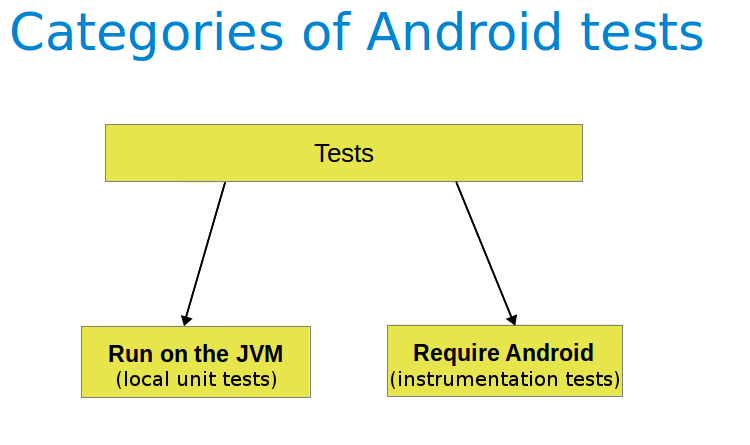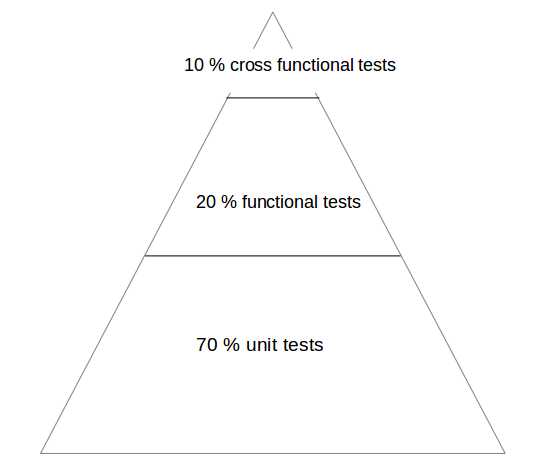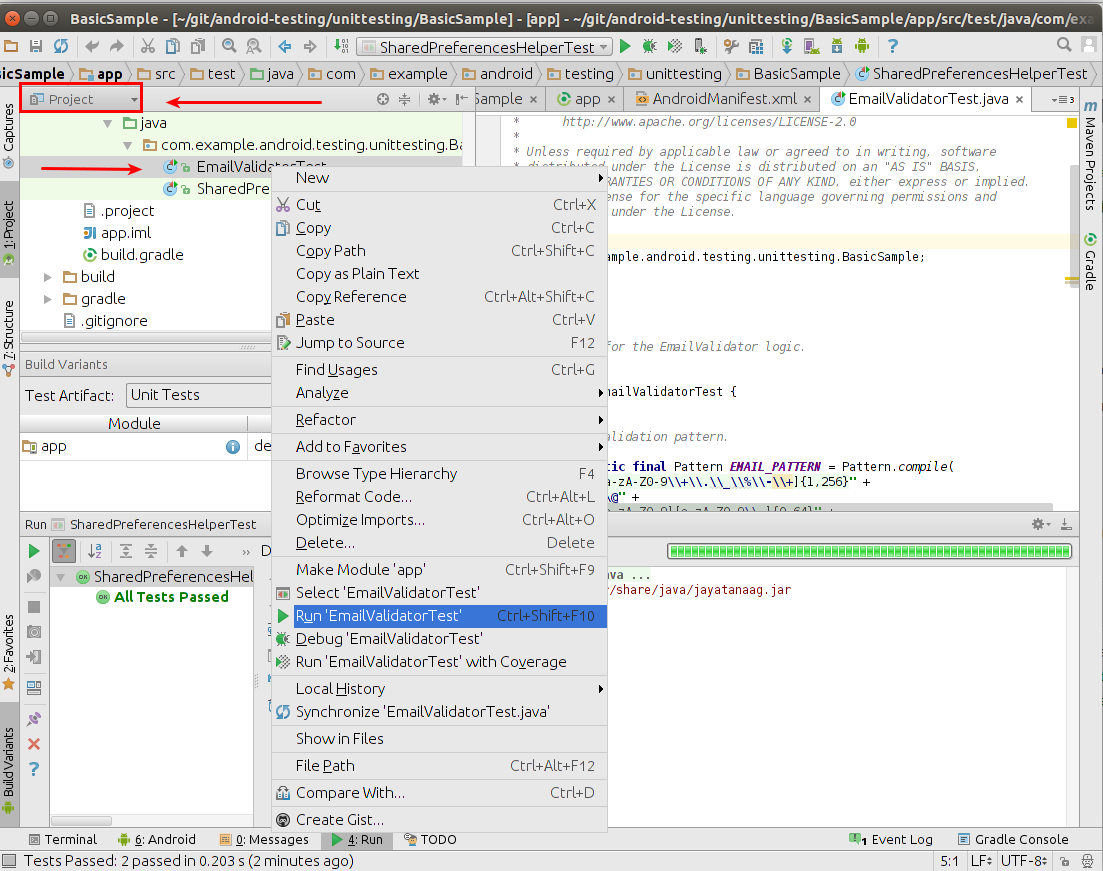- Developing Android unit and instrumentation tests — Tutorial
- 1. Introduction into Android testing
- 1.1. Testing Android applications
- 1.2. What to test on Android applications
- 1.3. Tooling support for Android testing
- 1.4. Android project organization for tests
- 2. Android unit testing
- 2.1. Unit testing in Android
- 2.2. Required dependencies in the Gradle build file
- 2.3. Running the unit tests
- 2.3.1. Using Gradle
- 2.3.2. Using Android Studio
- 2.4. Location of test reports
- 2.5. Activating default return values for mocked methods in android.jar
- 3. Exercise: Create unit test
- 3.1. Preparation: Create Android project
- 3.2. Add JUnit dependency
- 3.3. Create test
- 3.4. Run unit tests
- 4. Writing tests to run on the Android device
- 4.1. Instrumentation tests
- 4.2. How the Android system executes tests
- 4.3. Mocking objects in Android
- 4.4. Location of instrumentation tests
- 4.5. Define dependencies and testInstrumentationRunner in the Gradle build file
- 4.6. Using the @RunWith(AndroidJUnit4.class)
- 4.7. Run the tests on Android
- 4.8. Location of test reports
- 4.9. How to replace the application for instrumentation tests
- Android unit tests gradle
- About
Developing Android unit and instrumentation tests — Tutorial
This tutorial describes how to write unit and instrumentation tests for your Android application. It describes how to execute these tests via Android studio and Gradle. This tutorial assumes that you are familiar with Android programming in general.
1. Introduction into Android testing
1.1. Testing Android applications
Android applications run on a variety of devices. Also the Android framework and the surrounding open source frameworks evolve at a high speed. To ensure that you application works well, it is import to write software tests. This helps you to enhance and maintain the Android application.
Unit testing for Android can be classified into:
Local unit tests — tests which can run on the JVM.
Instrumented unit tests — tests which require the Android system.
Local unit tests run much faster compared to the time required to deploy and run tests on an Android device. Prefer writing local unit tests and only run tests on Android, if you require a real Android system.
If you write local unit test and have dependencies to Android API, you need to replace them, e.g., via a mocking framework like Mockito.
1.2. What to test on Android applications
Your test should focus on the business logic of your application. A good rule of thumb is to have the following distribution of tests:
70-80 % unit tests to ensure stability of your code basis
20-30 % functional tests to ensure that the application really works
some cross functional tests if your application integrates intensively with other Application components
You should test your application at least on one device with the lowest possible configuration. In addition you should test on one device with the highest available configuration, e.g., pixel density, screen resolution to ensure that it works fine on these devices.
1.3. Tooling support for Android testing
The Android Testing Support library (ATSL) project from Google provides tooling for Android testing. For example, it ( AndroidJUnitRunner ).
If you run local unit tests, a special version of the android.jar (also known as the Android mockable jar ) is created by the tooling. This modified JAR file is provided to the unit test so that all fields, methods and classes are available. Any call to the Android mockable JAR results, by default, in an exception, but you can configure Android to return default values. See Activating default return values for mocked methods in android.jar for details.
The library provides a JUnit 4-compatible test runner ( AndroidJUnitRunner ), the Espresso test framework and the UI Automator test framework. Espresso test framework can be used to test the User Interface of your application. UI Automator allows to write cross application functional tests.
AndroidJunitRunner provides access to the instrumentation API, via the InstrumentationRegistery .
InstrumentationRegistry.getInstrumentation() , returns the Instrumentation currently running.
InstrumentationRegistry.getContext() , returns the Context of this Instrumentation’s package.
InstrumentationRegistry.getTargetContext() , returns the application Context of the target application.
InstrumentationRegistry.getArguments() , returns a copy of arguments Bundle that was passed to this Instrumentation. This is useful when you want to access the command line arguments passed to the instrumentation for your test.
It also gives access to the life cycle via the ActivityLifecycleMonitorRegistry .
1.4. Android project organization for tests
The following is the default directory structure for your application and test code:
app/src/main/java — for your source code of your main application build
app/src/test/java — for any unit test which can run on the JVM
app/src/androidTest/java — for any test which should run on an Android device
If you follow this conversion, the Android build system runs your tests on the correct target (JVM or Android device).
If you receive the following error message: «error duplicate files in path. Path in archive: LICENSE.txt» you can add the following to your app/gradle.build file.
2. Android unit testing
2.1. Unit testing in Android
A unit test verifies in isolation the functionality of a certain component. For example, assume a button in an Android activity is used to start another activity. A unit test would determine, if the corresponding intent was issued, not if the second activity was started
A unit tests for an Android application can be:
local unit test — which runs on the JVM
Android unit test — which runs on the Android runtime
If they run on the JVM, they are executed against a modified version of the android.jar Android library. In this version all final modifiers have been stripped off. This makes it easier to use mocking libraries, like Mockito.
The local unit tests of an Android project should be located in the app/src/test folder.
2.2. Required dependencies in the Gradle build file
To use JUnit tests for your Android application, you need to add it as dependency to your Gradle build file.
2.3. Running the unit tests
2.3.1. Using Gradle
Run your unit tests with the gradlew test command.
2.3.2. Using Android Studio
To run a unit test, right-click on your test class in the Project window and select Run.
2.4. Location of test reports
The Test reports are created in the app/build/reports/tests/debug/ directory. The index.html gives an overview and links to the individual test pages.
2.5. Activating default return values for mocked methods in android.jar
By default, all calls to methods in the modified android.jar file throw exceptions. This default should ensure that your unit tests only test your code and do not depend on any particular behavior of the Android platform. If you want to configure a certain behavior, you can use a mocking framework to replace these call.
You can also instruct the Gradle build system to return default values for method calls in the `android.jar`with the following configuration in your Gradle build file.
3. Exercise: Create unit test
In this exercise you learn how to create a simple JUnit4 test for an Android project.
3.1. Preparation: Create Android project
Create the Android project as described in Android temperature converter.
3.2. Add JUnit dependency
Ensure you have the dependency to Junit in your app/build.gradle file.
3.3. Create test
In your app/src/test directory create the following two test methods for the ConverterUtil class.
3.4. Run unit tests
Ensure your unit tests are correctly implemented by running test tests. They should run successfully.
4. Writing tests to run on the Android device
4.1. Instrumentation tests
The Android testing API provides hooks into the Android component and application life cycle. These hooks are called the instrumentation API and allow your tests to control the life cycle and user interaction events.
Under normal circumstances your application cannot control the life cycle events and the user drives the application. For example, if Android creates your activity the onCreate() method is called. Or if the user presses a button your corresponding code is called. Via instrumentation you can control these events via your test code. For example, your instrumentation test can start the activity. Afterwards, it can call the finish() and restart the activity to test if the instance state of the activity is correctly restored.
Instrumented unit tests are unit tests that run on Android devices and emulators instead of running on the Java virtual machine. These tests have access to the real device and its resources and are useful to unit test functionality which cannot be easily mocked by mocking frameworks. An example is a test which validates a Parcelable implementation.
An instrumentation-based test class allows you to send key events (or touch events) to the application under test.
With user interface testing framework like Espresso, the developer rarely has to use the instrumentation API directly.
4.2. How the Android system executes tests
The InstrumentationTestRunner is the base test runner for Android tests. This test runner starts and loads the test methods. Via the instrumentation API it communicates with the Android system. If you start a test for an Android application, the Android system kills any process of the application under test and then loads a new instance. It does not start the application, this is the responsibility of the test methods. The test method controls the life cycle of the components of the application.
The test runner also calls the onCreate() method of the application and activity under test during its initialization.
4.3. Mocking objects in Android
The mocking framework Mockito can also be used for instrumentation tests. This allows you to replace parts of the Android system which are not interesting for the test. The Android framework provided in the past specialized mocking classes but these are not necessary anymore.
4.4. Location of instrumentation tests
As described in Android project organization for tests the unit tests of an Android project should be located in the app/src/androidTest/java folder.
4.5. Define dependencies and testInstrumentationRunner in the Gradle build file
To use JUnit tests for your Android application you need to add the dependency to JUnit to your Gradle build file. You also need to specify android.support.test.runner.AndroidJUnitRunner as testInstrumentationRunner in the build file.
4.6. Using the @RunWith(AndroidJUnit4.class)
It is also recommended annotating the test with the @RunWith(AndroidJUnit4.class) annotation. AndroidJUnit4 extends JUnit4, so if you use pure Junit4 syntax and ActivityTestRule it is not required. But you need it, if you want to run, i.e., Espresso tests with ActivityTestRule and JUnit4.
4.7. Run the tests on Android
Run your local unit tests via Gradle with the gradlew connectedCheck command.
To run your local unit tests via Android Studio, right-click on your test class in the Project window and select Run.
4.8. Location of test reports
The test reports are created in the app/build/reports/androidTests/connected/ directory. The index.html gives an overview and links to the individual test pages.
4.9. How to replace the application for instrumentation tests
You can replace the application class for the instrumentation tests by overriding the AndroidJUnitRunner and its newApplication method.
Источник
Android unit tests gradle
Android Unit Test
A Gradle plugin to add unit testing to the Android’s plugin. Prepared for Robolectric.
Since version 1.1 of the Android Gradle plugin, unit tests in JVM are natively supported. That is why I’m deprecating this plugin and won’t be maintaining it further, this means no bug fixes nor enhancements. Thanks for your continuous support all these days.
Add the plugin to the buildscript’s dependencies like this:
Apply the android-unit-test plugin AFTER you declare the Android’s plugin and configure it. Like this:
Add dependencies. The plugin adds several configurations. It adds a test configuration testCompile , one for each build type (Debug, . ) and one for each flavor declared in the Android extension. For example:
Add tests. The plugin adds several source sets. A master test source set src/test/java , a source set for each build type except release, a source set for each flavor, a source set for each combination of flavor and build type, a source set for each flavor group and a source set for each combination of flavor group and build type. For example:
- Main tests: src/test/java/*Test.java
- Debug build type tests: src/testDebug/java/*Test.java
- Free flavor tests: src/testFree/java/*Test.java
- FreeBeta grouped flavors (different flavor groups): src/testFreeBeta/java/*Test.java
- Free flavor & Debug build type: src/testFreeDebug/java/*Test.java
- FreeBeta grouped flavors & Debug build type: src/testFreeBetaDebug/java/*Test.java
Warning: All tests must end in *Test.java , otherwise, the plugin will not detect them as tests.
Preferably, Add the applicationId in the android.defaultConfig section. This is because the R.java file is always generated under this package name and Robolectric will try to read the resources from this package name. If you specify a different package name for your flavor, Robolectric would think the R.java class is under this package name. To solve this, the plugin reads the main package name and injects it as a system property so the custom runner can initialize Robolectric correctly. If you don’t specify this ID, the plugin will try to read it from the main manifest. For example:
Annotate your tests that need Robolectric with @RunWith(RobolectricTestRunner.class) or whatever custom runner you use.
- Run gradlew test to run the JUnit tests only.
- Run gradlew check to run both JUnit tests and instrumentation tests.
- Run gradlew testPaidNormalDebug to run a single variant tests.
Optionally you can use system properties to select a subset of the tests to run:
- -Dtest.single property will set a include pattern for all variants.
- -DtestPaidNormalDebug property will set a include pattern only for that specific variant.
- gradlew test -Dtest.single=NormalTest would run all variants but only the variants with the Normal flavor would find this test and run it.
- gradlew testPaidNormalDebug -DtestPaidNormalDebug.single=NormalTest would only run the PaidNormalDebug variant and only the test NormalTest.
- gradlew testPaidNormalDebug -Dtest.single=NormalTest would achieve the same of the above one.
- gradlew testPaidNormalDebug -Dtest.single=BetaTest would not find any test to run and pass with 0 errors.
- gradlew test -Dtest.single=NormalTest -DtestPaidNormalDebug.single=PaidTest would run the NormalTest in all variants that has it and PaidTest only in PaidNormalDebug variant.
Note: Using any of this two flags will override the default pattern of **/*Test.class which would mean that your tests will not have to end in *Test.java to be recognized, so pay attention!
Read the results. Gradle generates reports and results in build/test-report/ and build/test-results/ respectively. Each variant will have its independent report. For example build/test-report/freebeta/debug/index.html . But there will be a merged report with all tests in build/test-report/index.html .
Optionally, you can use the plugin’s extension to configure some options. For example:
- Gradle 2.1 or superior.
- Android’s Gradle Plugin 0.14.0 or superior.
- If using Robolectric, it should be 2.3 or superior.
- An Android app or library that builds with Gradle.
Running the Sample App
To run the sample app you’ll need to first install the SNAPSHOT version of this plugin. This is easily done with a simple instruction:
After the installation of the SNAPSHOT version you can run the example with another simple command:
As you can notice, the example is run with the gradle wrapper of the main project. Hence the need of ../ ( ..\ on Windows) to run the wrapper inside the example dir.
The wrapper should download Gradle 2.2.1. The example depends on Android’s plugin version 1.0.0 which it will also download. Finally the example needs Android platform 21 and build tools 21.1.2. If you don’t have them, you can either download them from the SDK Manager, or you can modify the build.gradle file and put the platform and build tools you use.
Integrating with Android Studio
There is an Intellij plugin to integrate with Android Studio. Follow the instructions in their README.
- Robolectric team for making an awesome test framework.
- Square’s plugin that inspired this plugin: https://github.com/square/gradle-android-test-plugin.
- Evant’s Android Studio plugin for making life easier.
- All contributors for helping this plugin grow.
About
Gradle plugin to add unit testing to android plugin. Prepared for Robolectric.
Источник






